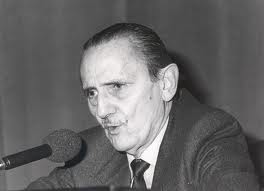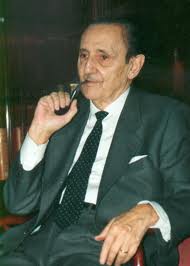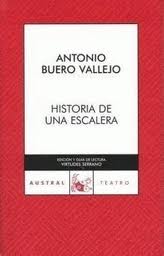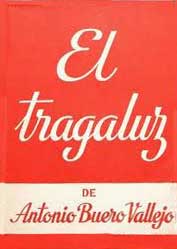Life & works of Antonio Buero Vallejo
Antonio Buero Vallejo is considered to be the best play writer of the 20th century. His plays, especially "Historia de una escalera" continue to be represented in theatres all over the world, and even some schools stage his plays.
Antonio Buero Vallejo - Life

Antonio Buero Vallejo was born in Guadalajara (Castile la Mancha) in 1916. He spent his childhood in La Alcarria except for a couple of years (1927-1928) when the family moved to Larache (Morocco). He became an avid reader in his father's extensive library, and he also liked music and painting: he drew incessantly from age 4. His father often took him to the theatre and when he was 9 he started directing his own plays in a miniature theatre.
Buero Vallejo studied his bachelors degree in Guadalajara (Madrid) from 1926 to 1933 and became interested in philosophy, science and social studies. In 1934 the family moved to Madrid, where Buero Vallejo enrolls in the "Escuela de Bellas Artes de San Fernando", where he alternated between assisting to his classes, attending theatre and reading. He doesn't enlist in any party but he feels closer to Marxism.
In 1937 he was called up and joined an infantry battalion. He contributed in "La Voz de la Sanidad with texts and drawings. In Benicasim, near Valencia, he meets Miguel Hernandez. At the end of the war, Buero Vallejo is in Valencia and he's put in a concentration camp in Sonja. A few days later he's allowed to return home with the promise he'll present himself to the local authorities, which he doesn't do. He begins to work in the reorganization of the Communist Party, which he'd joined during the war.

In May of June of 1937 he detained and condemned to death for adherence to the rebellion, but after 8 months they sentence him to 30 years instead. He's moved from one jail to another, and spends his time writing about painting and drawing portraits. In 1946 he's left out in parole, but he's banished from Madrid. He establishes himself in Carabanchel Bajo and becomes a member of the Ateneo. He publishes some drawings in several magazines, but he's already more attracted towards narrative and theatre.
He writes his first drama about blindness, "En la ardiente oscuridad" in 1946, and "Historia despiadada" and "Otro juicio de Salomón" in 1948. "Historia de una escalera" was written between 1947 and 1948, and he presented it for the Lope de Vega prize, which he won. The play was staged in Madrid in 1949, with great success among the audience and the critics. In the 50s he releases "La tejedora de sueños" and several other plays, among them "Un soñador para el pueblo", his first historical drama.

In 1954 the release of his play "Aventura en lo gris" was banned, and a year later he writes an ironic article on censorship. In 1959 he marries Victoria Rodríguez, with whom he had two children. In the 70s he manages to release some of his plays in spite of the censorship, and he also stages "Las Meninas", his biggest success after "Historia de una escalera".
In 1963 he's asked to join the Board of Theatre, but Buero Vallejo doesn't accept it. In 1967 he releases "El tragalauz", the first play released under the dictatorship that spoke openly about the Spanish Civil War. He was member of the Real Academia Española from 1971 and was awarded the National Prize for Spanish Letters in 1996, and the Cervantes Prize in 1986.
Antonio Buero Vallejo - Works
The works of Buero Vallejo can be divided in:
- Symbolist theatre: "En la ardiente oscuridad". Buero symbolizes the limitations of human beings by adding flaws to his characters. It symbolizes imperfections and the absence of freedom to understand ourselves and our point in life. Men aren't free because they can't understand the misteries surrounding them.
- Social criticism: These plays analyze the Spanish society, with all its injustices, lies and violence. It's seen in plays like "Historia de una escalera", which is one of the most important plays of its time, because of the impact it caused for its realism and social content. In "El tragaluz", Buero Vallejo subtly denounces the problems with the dictatorship and its obsession with influencing the people's vision of history and future events.
- Historical dramas: like "El sueño de la razón" or "Un soñador para el pueblo". "El sueño de la razón" is set in Madrid in 1823 under the rule of Ferdinand VII, in his fight against liberals. The main character is Goya, and through his deafness Buero Vallejo points out the incapacity some people have of hearing the sense of reality. "Un soñador para el pueblo" tells the story of the failures of a man in trying to better the living conditions of the inhabitants of a village.

The works of Buero Vallejo stand out thanks to his ability to create interesting and appealing characters, which are normally characterized by having physical or mental flaws, with complex personalities that evolve with the play. Characters are never reduced to symbols, and they've been divided in active and contemplative characters by the critics:
- The first ones lack scruples and their actions are always caused by their own selfishness; they don't doubt in being cruel or violent if it serves them.
- On the other hand. contemplative characters are those that feel anguish because the world they live in is too small. They move in a universe without hope, and dream about the impossible even though they know they're destines to failure and will never see their wishes come true.

